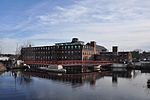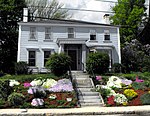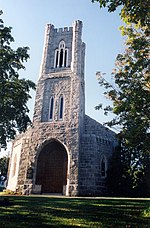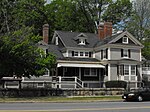Turnpike House
1805 establishments in MassachusettsBuildings and structures demolished in 1984Demolished buildings and structures in MassachusettsEssex County, Massachusetts Registered Historic Place stubsHouses completed in 1805 ... and 3 more
Houses in Methuen, MassachusettsHouses on the National Register of Historic Places in Essex County, MassachusettsNational Register of Historic Places in Methuen, Massachusetts
The Turnpike House was a historic house in Methuen, Massachusetts. It was a 1+1⁄2-story wood-frame structure with a side-gable roof and a granite foundation, with two interior chimneys. The main entrance was flanked by full-length sidelight windows, and a two-story wing was added to its rear early in the 20th century. It was built, probably in 1806, after the construction of Essex Turnpike through Methuen, and was one of the city's oldest buildings. It was listed on the National Register of Historic Places in 1984, and demolished the same year.
Excerpt from the Wikipedia article Turnpike House (License: CC BY-SA 3.0, Authors).Turnpike House
Hampshire Street, Methuen
Geographical coordinates (GPS) Address Nearby Places Show on map
Geographical coordinates (GPS)
| Latitude | Longitude |
|---|---|
| N 42.729722222222 ° | E -71.19 ° |
Address
Hampshire Street 65;67
01841 Methuen
Massachusetts, United States
Open on Google Maps











